Transformational Gardening
January 2011 Foraging Experiences
(Forward to:
February 2011 Foraging Experiences)
January 8, 2011
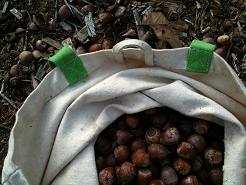
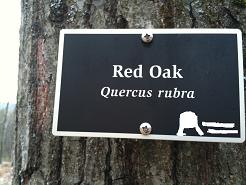 Most of the 11-1/2 gallons of acorns I picked were Red Oak from this hiking park.
I dried the acorns for 3 weeks. Then I shelled them trying various methods including
hitting the shells lightly with a hammer to crack them. I tried the towel method outlined
in Samuel Thayer’s book, “Nature’s Garden.” The towel method is
faster for cracking them, but takes time to line the acorns up. I think a simple hand nut
cracker might actually be faster. After picking out the acorn nuts, I removed the acorn
skin.
Most of the 11-1/2 gallons of acorns I picked were Red Oak from this hiking park.
I dried the acorns for 3 weeks. Then I shelled them trying various methods including
hitting the shells lightly with a hammer to crack them. I tried the towel method outlined
in Samuel Thayer’s book, “Nature’s Garden.” The towel method is
faster for cracking them, but takes time to line the acorns up. I think a simple hand nut
cracker might actually be faster. After picking out the acorn nuts, I removed the acorn
skin.
I tried grinding the acorns in my Country Living grain mill (and even tried using the
special corn/bean auger made for oily grains/beans). But acorns do not grind well at all using
the Country Living mill. I ended up hand grinding them with a motar and pestal -- a process
that took a very long time.
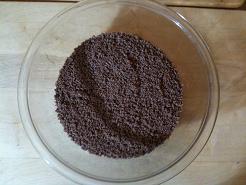
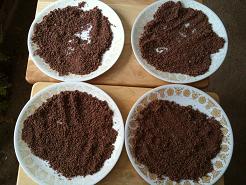 After grinding the acorns, I cold water leached out the tannins for two weeks, changing the
water 2-3 times per day. The leaching was done after approximately 9 days, but I kept
going until I was ready to make bread on the weekend. This is the slow method of cold
water leaching. Using running cold water can leach the acorns in less than 1 day.
After grinding the acorns, I cold water leached out the tannins for two weeks, changing the
water 2-3 times per day. The leaching was done after approximately 9 days, but I kept
going until I was ready to make bread on the weekend. This is the slow method of cold
water leaching. Using running cold water can leach the acorns in less than 1 day.
By the time the acorns were done leaching, my Corona grinder arrived. I squeezed out the leached
acorn meal and ran is through the Corona grinder once to make it the consistency of corn meal.
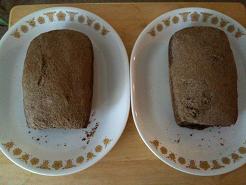 Bread Recipe:
Bread Recipe:
2-1/2 cups fresh organic whole wheat flour
3/4 cup of acorn meal
3/4 cup of sourdough (made with 1-1/2 cups whole wheat flour, 1 cup water, yeast)
1-1/2 teaspoons sea salt
7/8 cup water
3 Tablespoons of honey or maple syrup
Kneed the dough for 8-10 minutes. Let the dough rise for several hours and kneed again.
Let the dough rise again. Oil the bread pan and bake at 350 degrees Fahrenheit for no more
than 1 hour.
Next time I make acorn bread, I'll have all of the tools I need to process the acorns
quickly.
January, 22 2011
Oxeye Daisy (Leucanthemum vulgare) (Previously: Chrysanthemum leucanthemum)
and
Red Clover (Trifolium pratense)
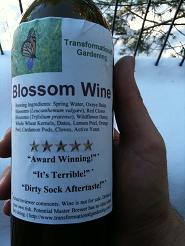
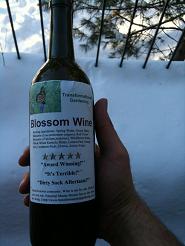 I was very excited to try my first bottle of wine! In general, I'm not a big fan of wine
and I liked this wine about as much as any other. I have been drinking 1-2 cups per day
for about one week. No negative side effects. It does taste better chilled.
I was very excited to try my first bottle of wine! In general, I'm not a big fan of wine
and I liked this wine about as much as any other. I have been drinking 1-2 cups per day
for about one week. No negative side effects. It does taste better chilled.
A number of my friends didn't like the taste very much. See the quotes on the label
(image to the right). But a few of them thought it was anywhere from “okay”
to “good.” I will make wine with just red clover (no oxeye daisy) next
year as that seems to be the most common recipe.
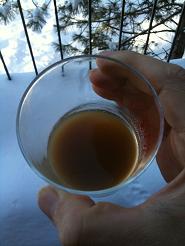
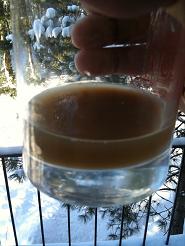 Now there seems to be some concern amongst some foragers and others about fermented
red clover to make wine. The evidence I have found makes me feel that it is not a problem.
But everyone has to make their own decision.
Now there seems to be some concern amongst some foragers and others about fermented
red clover to make wine. The evidence I have found makes me feel that it is not a problem.
But everyone has to make their own decision.
The claim was that red clover (Trifolium pratense) has significant amounts of coumarins.
When coumarins are fermented, they often produce another form of coumarin called dicoumarol.
Dicoumarol has drug-like effects that prevents blood clotting.
Other plants such as sweet clover (Melilotus alba and Melilotus officinalis)
are used as hay for livestock. These species are known to have significant amounts of coumarins
and if they get moldy, the dicoumarol produced can kill some livestock. This led some clinicians
and even some foragers to assume that red clover (Trifolium pratense) has significant
amounts of coumarins and might produce similar effects.
The latest research I have seen seems to indicate that red clover contains only very small levels
of coumarines. In “Confusion regarding anticoagulant coumarins in dietary supplements”
(Clinical Pharmacology & Therapeutics, Volum 76, No. 6, Pages 511-516, 2004), the
researchers measured tested for 17 coumarins. Their combined concentration was 690 ppm (parts
per million) or ~0.07% coumarins in the red clover extract. The researchers point out that
“consumption of 400 mg/day of this red clover extract would result in a dose of less
than 0.28 mg/day (690ppm) of all 17 coumarins combined. Dicoumarol doses of 25-200 mg/day
are needed to produce clinically significant anticoagulant effects, and the concentration
of dicoumarol in the extract was about 100 times less than the lowest dose.” A news clip of
this article can be found at:
http://www.montanaim.com/pubs/050155-291.pdf.
In “The Chemical and Biological Profile
of a Red Clover (Trifolium pratense) Phase II Clinical Extract” (Journal of
Alternative and Complementary Medicine, Volume 12, No. 2, Pages 133-139, 2006), the researchers
measured less than 0.03% coumarines in the raw unformulated red clover extract. While
this level of coumarins is very low, not all chemical in red clover have been identified.
A draft of this paper can be found at:
http://www.ncbi.nlm.nih.gov/pmc/articles/PMC1780253/.
For Melilotus species, the coumarin content can vary widely. In a study of Melilotus
species in South Australia, the coumarin content varied from very low: 0.06% to high:
0.943% depending upon the species tested. (“Variation in coumarin content of
Melilotus species grown in South Australia,” New Zealand Journal of Agricultural
Research, Volume 53, Pages 201-213.)
While neither of the first two studies mentioned above used a fermented red clover product
such as wine, the levels of coumarins that might be converted into dicoumarol was very low.
Other plants contain coumarins such as wild carrot, lemons, cinnamon, strawberries, cherries,
sweet woodruff and the herb qong quai. If you look for “red clover wine” on the
Internet, you can see that others drink it without reported effects. In an ideal world, I would like to
see dicoumarol levels measured in red clover wines. But until then I believe it is safe
for me to drink the wine I made.

 Most of the 11-1/2 gallons of acorns I picked were Red Oak from this hiking park.
I dried the acorns for 3 weeks. Then I shelled them trying various methods including
hitting the shells lightly with a hammer to crack them. I tried the towel method outlined
in Samuel Thayer’s book, “Nature’s Garden.” The towel method is
faster for cracking them, but takes time to line the acorns up. I think a simple hand nut
cracker might actually be faster. After picking out the acorn nuts, I removed the acorn
skin.
Most of the 11-1/2 gallons of acorns I picked were Red Oak from this hiking park.
I dried the acorns for 3 weeks. Then I shelled them trying various methods including
hitting the shells lightly with a hammer to crack them. I tried the towel method outlined
in Samuel Thayer’s book, “Nature’s Garden.” The towel method is
faster for cracking them, but takes time to line the acorns up. I think a simple hand nut
cracker might actually be faster. After picking out the acorn nuts, I removed the acorn
skin.
 After grinding the acorns, I cold water leached out the tannins for two weeks, changing the
water 2-3 times per day. The leaching was done after approximately 9 days, but I kept
going until I was ready to make bread on the weekend. This is the slow method of cold
water leaching. Using running cold water can leach the acorns in less than 1 day.
After grinding the acorns, I cold water leached out the tannins for two weeks, changing the
water 2-3 times per day. The leaching was done after approximately 9 days, but I kept
going until I was ready to make bread on the weekend. This is the slow method of cold
water leaching. Using running cold water can leach the acorns in less than 1 day. Bread Recipe:
Bread Recipe:
 I was very excited to try my first bottle of wine! In general, I'm not a big fan of wine
and I liked this wine about as much as any other. I have been drinking 1-2 cups per day
for about one week. No negative side effects. It does taste better chilled.
I was very excited to try my first bottle of wine! In general, I'm not a big fan of wine
and I liked this wine about as much as any other. I have been drinking 1-2 cups per day
for about one week. No negative side effects. It does taste better chilled.
 Now there seems to be some concern amongst some foragers and others about fermented
red clover to make wine. The evidence I have found makes me feel that it is not a problem.
But everyone has to make their own decision.
Now there seems to be some concern amongst some foragers and others about fermented
red clover to make wine. The evidence I have found makes me feel that it is not a problem.
But everyone has to make their own decision.